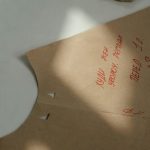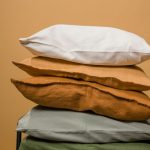Have you ever wondered what goes into making a sewing needle? Sewing needles are an essential tool for anyone who loves to sew. They come in a variety of sizes and types, each with their own specific uses. But what are they made of, and how are they manufactured?
The materials used to make sewing needles have evolved over time. Historically, needles were made of bone, ivory, or even thorns. Today, needles are made of high-quality steel wire, which is then polished to create a smooth and sharp point.
The manufacturing process is complex and precise, with each needle being carefully crafted to ensure its quality and durability. Knowing what goes into making a sewing needle can help you choose the right one for your project and ensure that it lasts for years to come.
Table of Contents
The Importance of Sewing Needles
Sewing needles are crucial to any sewing project and you’ll want to make sure you’re using the right one! Not all needles are created equal and using the wrong one can result in frustration, damaged fabric, and even injury. Choosing the right needle will not only make your sewing experience more enjoyable, but it will also ensure that your finished product is of the highest quality.
When selecting a needle, there are a few factors to consider. The first is the type of fabric you will be sewing. Different fabrics require different needle sizes and types. For example, a denim needle is stronger and thicker than a regular needle, making it suitable for sewing heavier fabrics. On the other hand, a ballpoint needle is designed for knit fabrics, as it has a rounded tip that won’t damage the delicate fibers.
Another factor to consider is the type of thread you will be using. If you’re using a thicker thread, you’ll need a needle with a larger eye to accommodate it. Similarly, if you’re working with a delicate thread, you’ll want a needle with a smaller eye to prevent the thread from slipping out. Choosing the right needle for your thread will ensure that it doesn’t break or fray during the sewing process.
Choosing the right sewing needle is essential for a successful sewing project. Take the time to consider the type of fabric and thread you’ll be working with, and choose a needle that is appropriate for both. With the right needle, you’ll be able to sew with ease and create beautiful, high-quality garments and accessories.
Materials Used to Make Sewing Needles
You’ll be surprised to learn what types of materials are used to craft these essential tools for your stitching projects. Sewing needles are typically made from metals such as steel, nickel, and titanium. Each material has its unique properties that make it suitable for specific types of fabrics and sewing techniques.
Steel needles are the most common type and are suitable for general sewing projects. They’re sturdy, durable, and can handle thicker fabrics such as denim and leather.
Nickel needles, on the other hand, are more flexible and glide smoothly through lightweight fabrics such as silk and chiffon. They’re also resistant to rust and corrosion, making them ideal for long-term use.
Titanium needles are the newest addition to the sewing needle family and are known for their superior strength and durability. They’re also resistant to breaking and bending, making them perfect for heavy-duty projects such as quilting and embroidery.
Regardless of the material used, it’s essential to choose the right needle size and type for your specific sewing needs to achieve the best results.
The Process of Making Sewing Needles
When crafting these essential tools for your stitching projects, it’s fascinating to witness the process of how different types of metals are shaped and crafted into the perfect needle for specific fabrics and techniques. The process of making sewing needles involves several steps, starting with the selection of the metal. The most common metals used for making sewing needles are steel, stainless steel, and nickel-plated steel. Once the metal is chosen, it’s melted and poured into long rods called billets.
The billets are then cut into the desired length and size of the needle. The next step is to shape the needle by grinding it into its final form. This is done using specialized machines that are designed to grind the metal into a thin, pointed needle. The needle is then polished to remove any rough edges and to give it a smooth finish.
The needle is inspected for quality control to ensure that it’s free of any defects or imperfections. This is done by passing the needle through a series of tests, including a visual inspection and a test for strength and durability. Once the needle passes all of these tests, it’s packaged and sent to stores for purchase. With the right needle, you can create beautiful stitching projects that will last a lifetime.
| Metal Type | Pros | Cons |
|---|---|---|
| Steel | Durable and strong | Prone to rusting |
| Stainless Steel | Resistant to rusting | Not as strong as steel |
| Nickel-Plated Steel | Resistant to rusting and corrosion | More expensive than other types |
Types of Sewing Needles
When it comes to sewing, it’s important to use the right type of needle for the job. You’ll want to consider the thickness and type of fabric you’re working with and choose a needle accordingly.
Some common types of sewing needles include universal needles, ballpoint needles, and embroidery needles.
Let’s take a closer look at each of these options and when they’re best used.
Universal Needles
Hey, did you know that universal needles are made to work with most woven and knit fabrics, making them a versatile option for any sewing project? These needles have a slightly rounded tip and a sharp point, which allows them to easily penetrate through different fabric types without causing damage or leaving visible holes.
Here are some things you should know about universal needles:
- They come in a range of sizes, from 60/8 to 110/18, which means you can choose the right needle for your fabric thickness and weight.
- They are suitable for both natural and synthetic fabrics, such as cotton, wool, rayon, polyester, and nylon.
- They are great for general sewing tasks, such as stitching seams, hemming, topstitching, and quilting.
- They can be used with most sewing machines, including domestic and industrial models.
- They are a good option for beginners who are still experimenting with different fabrics and stitches, as they offer a lot of flexibility and forgiveness.
Overall, if you want a reliable needle that can handle a wide variety of fabrics and sewing techniques, universal needles are a great choice. Just be sure to change your needle regularly to ensure optimal performance and prevent any snags or breaks.
Ballpoint Needles
If you’re working with knit fabrics, you’ll want to consider using ballpoint needles as they have a rounded tip that glides between the fibers without damaging them. This type of needle is specifically designed for knit fabrics, which have a looser weave than other materials.
Ballpoint needles are also great for sewing on stretchy fabrics, as they can prevent skipped stitches and snags. The tip of the ballpoint needle is slightly rounded, which allows it to push aside the fibers of the knit fabric rather than puncturing them.
This means that the needle won’t snag or pull on the fabric, and it will help create a smoother and more even stitch. You can find ballpoint needles in a variety of sizes, so make sure to choose the right size for your project.
Embroidery Needles
Embroidery needles are perfect for adding intricate details and designs to your fabric creations, allowing you to create a personalized touch that truly stands out. Unlike regular sewing needles, embroidery needles have a larger eye and a sharp tip that can easily penetrate through multiple layers of fabric.
These needles come in various sizes, ranging from 1 to 10, with the larger numbers representing thinner needles. Embroidery needles are made from high-quality steel and are often coated with nickel or gold to prevent rust and corrosion. Some needles are also made with a titanium coating, which makes them stronger and more durable.
It’s important to choose the right size and type of embroidery needle for your project, as using the wrong needle can cause damage to your fabric or thread. With the right needle, you can create beautiful and intricate designs on your fabric creations that are sure to impress.
Needle Sizes and Uses
When it comes to sewing, understanding needle sizes is crucial for achieving the best results. Choosing the right needle for your project can make all the difference in the world.
Don’t be intimidated by the variety of needle sizes available – with a little knowledge, you’ll be able to confidently select the perfect needle for your next sewing project.
Understanding Needle Sizes
You’ll notice that needle sizes can vary depending on the type of sewing project you’re working on. This is because different fabrics and threads require different needle sizes to achieve the best results.
The size of a needle is determined by its diameter, which is measured in millimeters. The larger the diameter, the larger the needle size.
When choosing a needle size, consider the weight and type of fabric you’re working with. For example, if you’re working with lightweight fabrics like silk or chiffon, you’ll want to use a smaller needle size such as 60/8 or 70/10.
On the other hand, if you’re working with heavier fabrics like denim or canvas, you’ll need a larger needle size such as 100/16 or 110/18. By selecting the appropriate needle size, you can prevent fabric damage, skipped stitches, and thread breakage.
Choosing the Right Needle for Your Project
Selecting the proper needle size is essential to achieving high-quality results in your sewing projects. Different fabrics require different needle sizes, and using the wrong needle can result in skipped stitches, damaged fabric, or even broken needles.
As a general rule, the finer the fabric, the smaller the needle should be. For example, lightweight fabrics such as chiffon or silk require a smaller needle size like a 60/8 or 70/10, while heavier fabrics like denim or canvas require a larger needle size like a 100/16 or 110/18.
But needle size isn’t the only factor to consider when choosing the right needle for your project. You also need to consider the type of needle. There are needles designed for specific fabric types, such as stretch needles for knit fabrics or leather needles for leather and suede.
There are also specialty needles, such as quilting needles or embroidery needles, that have specialized tips and features to aid in those specific types of sewing. By selecting the right needle for your project, you can avoid frustration and achieve the best possible results.
How to Care for Your Sewing Needles
Properly maintaining your sewing needles is crucial to ensure their longevity and prevent frustration during your sewing projects. Here are some tips to care for your sewing needles:
-
Always store your needles in a dry and safe place, away from moisture or direct sunlight. This will prevent rusting and other types of damage that can affect the integrity of the needle.
-
Keep your needles clean by wiping them with a soft cloth after each use. This will remove any debris or residue that may have accumulated during your sewing session.
-
Avoid bending or breaking your needles by using the right size and type for your project. Using the wrong needle can cause damage to the fabric or affect the quality of your stitches.
-
If you notice that your needle is dull or not performing well, replace it immediately. Sewing with a dull needle can cause skipped stitches, uneven tension, or even damage to your machine.
-
Finally, be gentle when inserting and removing your needles from your machine. Forceful movements can cause damage to your machine’s needle holder, as well as to the needle itself.
By following these simple tips, you can ensure that your sewing needles remain in top condition, so you can enjoy your sewing projects with ease and confidence. Remember to always handle your needles with care, and they’ll serve you well for many years to come.
- A Deep Dive Into the World of Nonwoven Geotextiles - July 12, 2025
- How to Properly Wash and Care for Nonwoven Polypropylene Items - July 12, 2025
- Understanding the Strength and Weaknesses of Nonwoven Materials - July 12, 2025






